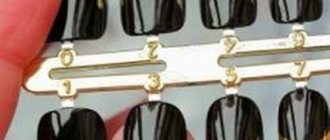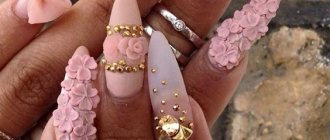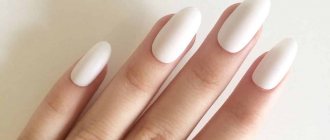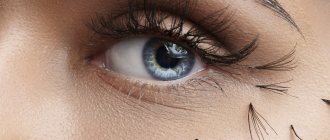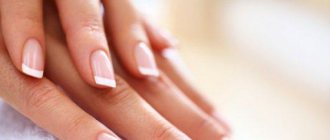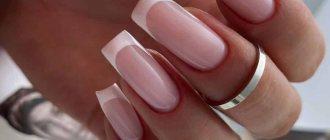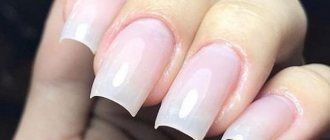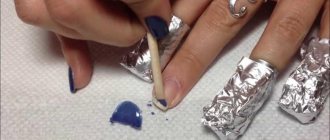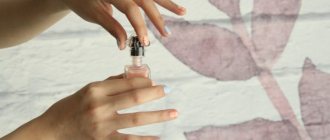Causes of inflammation
What is the cuticle? It is essentially a thin layer of skin that is located at the bottom of each nail. The main function of the cuticle is to protect the nails from dirt and bacteria. For some reasons, the cuticle becomes inflamed:
- This occurs due to fungal diseases.
- The cause is burrs that are not removed correctly. To avoid inflammation, it is better to use nail clippers.
- As a result of improper cuticle care. It subsequently becomes rougher, cracks, and becomes dry.
- Often the reason is an allergy to something: nail polish or hand cream.
- Inflammation of the cuticle on the finger can be caused by blows, bruises and other mechanical damage.
- This list includes ingrown toenails.
- Inflammation of the cuticle after a manicure is a common problem.
- Often, household chemicals have a detrimental effect on the skin of your hands.
- The habit of biting nails also provokes this unpleasant process.
Prevention
To prevent the development of cuticle inflammation and avoid treatment, or even worse, surgery, follow simple tips:
- get rid of the habit of biting your nails. The habit may be a consequence of increased levels of anxiety. If it is impossible to avoid temptation, contact a psychologist or neurologist who will identify the cause and help you get rid of it, including with the help of mild sedatives;
- avoid mechanical accidental injuries. When there is a risk of hitting or cutting yourself when performing some action, do not make sudden movements, do not rush;
- After contacting your hands with water, apply moisturizer. Dry skin is more susceptible to injury;
- Protect your hands from exposure to chemicals. Use gloves when working around the house, the same goes for craftsmen who often come into contact with disinfectants. It is better if the gloves have an inner cotton layer to absorb moisture;
- get your nails done by a professional. Monitor the sterility of instruments, as well as manicure technology. Refuse trimming equipment, giving preference to hardware, sawing or European - this way the risks are significantly reduced;
- take care of the condition of your hands and nails - avoid hangnails, regularly moisturize the skin and carry out caring procedures for nails and cuticles - masks, baths. Well-groomed hands are the best prevention of nail and cuticle diseases.
Types of inflammation
There are three main types of cuticle inflammation. The cause of acute inflammation can be a simple abrasion or any other damage to the finger. The process can develop from several hours to several days. In this case, treatment will help quickly.
The subacute form usually lasts several weeks. This is an intermediate stage between the acute and chronic forms. As for the last stage, it is quite long and can last about six weeks. Nails become brittle, change color, smoothness disappears, and begin to flake. If left untreated, the cuticle may separate from the nail plate, leaving no protection and allowing large numbers of bacteria to accumulate. Often the chronic form occurs in people suffering from diabetes, among laundry workers who come into contact with household chemicals almost every day. Cleaners and sellers are at risk.
What is inflammation after a manicure?
Inflammation is characterized by the following symptoms:
- the cuticle, and sometimes the skin on the finger, turns red;
- the affected area swells;
- painful sensations of a twitching or ticking nature appear;
- the damaged area has a higher temperature than the whole body;
- Eventually, the inflamed area breaks out.
Inflammation of the nail (nail plate)
Healthy nails look aesthetically pleasing. The main characteristics are:
- flesh pink color;
- smooth and even surface;
- without seals, i.e. the thickness is the same along the entire length of the nail.
When a nail becomes inflamed, its growth or even structure may change, brittleness and delamination may increase, or, conversely, thickening.
Grooves on the nails, both longitudinal and transverse, will tell an experienced master that the nail plate was previously injured.
The following color changes are often encountered: whitishness, yellowness or even blackening .
Inflammation of the cuticle
The cuticle is a skin rim that frames the nail plate. Inflammation becomes noticeable almost immediately and is difficult to miss. The delicate skin begins to turn red, a tumor often appears, and in advanced cases the inflamed area can fester .
Another sign of cuticle inflammation is itching and discomfort. As soon as you notice some changes near the cuticle, you should not ignore them, because it is the cuticle that provides the protective function of the body.
Inflammation of the finger near the nail
It occurs when the nail is cut incorrectly, that is, when the nail plate has not yet had time to grow, but it has already been cut off along its entire length, including the sides. As a result, the growth of the nail is disrupted; it is embedded in the side ridges, instead of growing straight.
How to treat cuticle inflammation?
To relieve sudden worsening inflammation, you can try making a special salt bath:
- Take a deep container and fill it with water. We monitor the temperature, it should not exceed 35-40 degrees.
- Add sea salt; if you don’t have it, regular salt will do. A teaspoon is enough. Instead of salt, you can use vinegar (3%).
- Keep your fingers in the bath for ten minutes.
- Rinse with water.
The procedure should be repeated every day, and if after four days there is no improvement, then a doctor’s examination is necessary. Baths with potassium permanganate also have a beneficial effect on the nail. The solution should be slightly pinkish. They can be done for about ten to fifteen minutes, every day, and the inflammation will go away.
Compresses with aloe juice help. We take a cotton swab, tangle it with juice and apply it. Or use a plant leaf cut lengthwise. A good solution would be baths with oak bark or chamomile. Honey cake is often used in folk medicine:
- Take 15 g of honey, add flour, mix so that you get a flat cake.
- First you need to disinfect the area of skin that is affected, and then apply the cake.
- The cake should be fixed.
- It is removed after twelve hours.
You can try treatment with herbs such as horse sorrel, plantain and St. John's wort. To do this, prepare the mixture:
- Take fresh leaves of the above plants and chop them finely.
- It should be a paste. We apply it to the affected area and secure it with a bandage.
Inflammation of the cuticles on the hands is often treated with a bath with St. John's wort. In this case, it is worth brewing 50 g of herb, fresh or dry, in boiling water (200 g). It is recommended to hold the infusion for at least thirty to forty minutes. The finger on which inflammation has formed is held for a quarter of an hour.
Folk remedies
Traditional medicine recipes can effectively fight diseases. These methods have absorbed the experience and wisdom of several generations of people. Many recipes have been collected over centuries. At the same time, several treatment options are offered for each disease.
Traditional medicine knows well how to treat an abscess on a finger. She has several dozen different recipes in store for this. The most effective are the following:
- Compress with baked onions. Accelerates the maturation of the purulent capsule and accelerates the release of its contents to the outside. The onion is cut into two parts. The halves are baked in the oven. When the onion has cooled, apply it to the affected area, fix it and leave it for several hours.
- Aloe. Peel the pulp from the leaf and apply it to the inflammation.
- Castor oil. Heat the substance to a temperature of 40 degrees in a water bath. Soak gauze in oil and place it on your finger.
- Flax seeds. An excellent remedy not only for felon, but also for furunculosis. Add a tablespoon of flax seeds crushed in a coffee grinder to 250 ml of boiling milk. In addition, you can add a few dried chamomile flowers. Boil the mixture for two to three minutes and strain. Apply the resulting mass to the inflammation and secure with a bandage. Leave for three hours.
- Milk foam. If your finger becomes infected after a manicure, you need to help ensure that the infection goes away as soon as possible. To do this you will need the fattest milk you can find. The liquid should be poured into a clay pot and placed in the oven. When brown foam forms on the surface of the milk, it must be removed and applied to the affected area. Apply a bandage on top and leave it overnight. Repeat the steps in the morning. The result will not take long to arrive. By the end of the second day, the pus will come out.
- Potatoes or beets. Vegetables help prevent the development of a pus sac. A paste of fresh beets or potatoes should be applied to the inflammation after baths with a hypertonic solution or potassium permanganate.
- Honey compress. For treatment you will also need a baking onion and flour. All ingredients, mixed in equal quantities, are thoroughly ground. The resulting paste is applied to the inflamed area, covered with gauze and secured with a bandage.
Drug treatment
In case of inflammation, the attending physician can often prescribe special ointments that relieve all symptoms of the disease. Let's look at the most popular ones.
Gentamicin ointment
The product is used three to four times a day. Treatment lasts from five to ten days.
Bacitracin ointments
A fairly common remedy with almost no side effects. It is recommended to use the ointment for five to ten days.
Bactroban
This ointment contains mupirocin, a substance with significant antibacterial properties. The product helps with severe inflammation. It is applied 2-3 times a day. The treatment period is the same as in the case of other ointments.
Ciclopirox
This ointment is used if fungi are the cause of inflammation. Apply it for exactly a month, no more than twice a day.
Vishnevsky ointment
This product is applied to a cotton pad, applied to the damaged area and secured with a bandage. Treatment works best before bedtime. The ointment is absorbed overnight, relieves various types of redness and draws out pus.
Cuticle inflammation on the hands can be cured with tablets. For example, we calculate the dosage of Amoxicillin in two ways:
- 500 mg / 125 mg – no more than 3 times a day;
- 875 mg/125 mg – 2 times a day.
The treatment period is about seven days. People suffering from kidney failure should calculate their individual dosage with their doctor.
Doctors' recommendations
If the area around the nail plate is red, but there is no pus, then it is quite enough to treat the affected area with an antiseptic. Before the procedure, do not forget to carefully cut off the burrs at the root.
If suppuration is present, then drugs such as Vishnevsky Ointment and Ichthyol Ointment will help. These are the most common ointments.
- Vishnevsky ointment. A universal anti-inflammatory agent. Its main function is to draw out trapped dirt and pus from the wound. This will allow the cuticle to heal further.
- Ichthyol ointment. Night compresses are most often used with this ointment. It relieves inflammation and speeds up the healing process.
If the inflammation gains momentum and suppuration develops, it is better to stop self-treatment. In most situations, surgery will be required. If the infection has gone deep into the soft tissue, then drainage will be required.
In these cases, you should immediately consult a doctor
Getting rid of inflammation caused by an allergic reaction is not as easy as commercials make it out to be. The doctor, in addition to antiallergic drugs, also prescribes antifungal drugs for both internal and external use. A positive outcome of treatment is visible only if all the doctor’s recommendations have been followed.
Only a doctor can cure inflammation caused by fungal bacteria effectively and without relapse. In case of severe fungal infection, a course of antibiotics is indicated, which can be selected correctly after a number of studies and only as prescribed by the attending physician.
ATTENTION ! Severe cases of ingrown toenails may require surgery. Although today doctors - podologists and dermatologists have learned to do without surgery, using titanium plates that clearly fix the problem nail
Preventive measures
To avoid a similar illness in the future, you must follow safety precautions:
- It is advisable to disinfect manicure instruments.
- If during a manicure the cuticle area is accidentally damaged, it should be immediately treated with an antiseptic solution.
- You should always have nourishing and softening products for the cuticle on hand.
- It is useful to do vitamin baths for your hands from time to time.
- When contacting household chemicals, use gloves.
